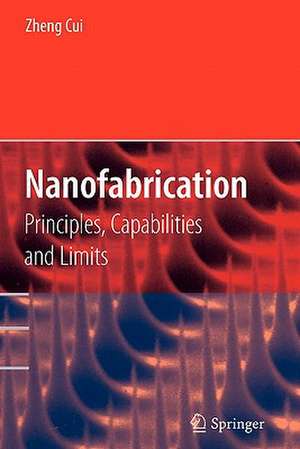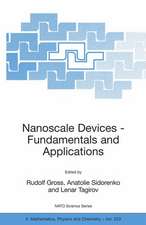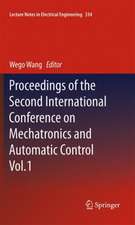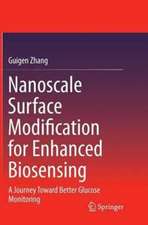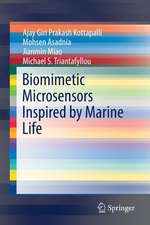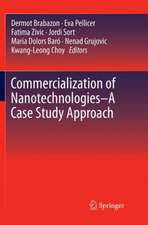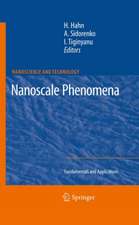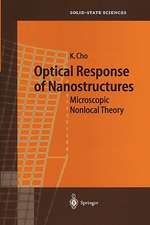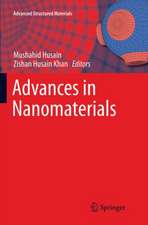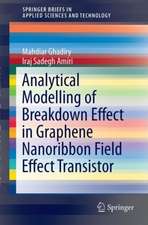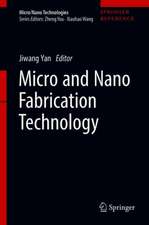Nanofabrication: Principles, Capabilities and Limits
Autor Zheng Cuien Limba Engleză Paperback – 4 noi 2010
Principles of each technology are introduced and illustrated with minimum mathematics involved. The capabilities of each technology in making sub-100nm structures are described. The limits of preventing a technology from further going down the dimensional scale are analyzed.
Drawing upon years of practical experience and using numerous examples, Zheng Cui covers state-of-the art technologies in nanofabrication including:
- Photon-based lithography
- Charged particle beams lithography
- Nanofabrication using scanning probes
- Nanoscale replication
- Nanoscale pattern transfer
- Indirect nanofabrication
- Nanofabrication by self-assembly
Written for: Nanoscience and nanotechnology researchers and engineers, technical professionals and academic researchers in the fields of electrtonics, mechanical engineering, and chemical engineering.
| Toate formatele și edițiile | Preț | Express |
|---|---|---|
| Paperback (2) | 897.33 lei 6-8 săpt. | |
| Springer International Publishing – 20 iun 2018 | 897.33 lei 6-8 săpt. | |
| Springer Us – 4 noi 2010 | 947.50 lei 6-8 săpt. | |
| Hardback (2) | 695.35 lei 38-44 zile | |
| Springer International Publishing – 15 iul 2024 | 695.35 lei 38-44 zile | |
| Springer International Publishing – 12 sep 2016 | 1230.35 lei 6-8 săpt. |
Preț: 947.50 lei
Preț vechi: 1155.48 lei
-18% Nou
Puncte Express: 1421
Preț estimativ în valută:
181.30€ • 189.29$ • 150.05£
181.30€ • 189.29$ • 150.05£
Carte tipărită la comandă
Livrare economică 05-19 aprilie
Preluare comenzi: 021 569.72.76
Specificații
ISBN-13: 9781441945365
ISBN-10: 1441945369
Pagini: 360
Ilustrații: XIV, 343 p. 177 illus.
Dimensiuni: 155 x 235 x 19 mm
Greutate: 0.5 kg
Ediția:2008
Editura: Springer Us
Colecția Springer
Locul publicării:New York, NY, United States
ISBN-10: 1441945369
Pagini: 360
Ilustrații: XIV, 343 p. 177 illus.
Dimensiuni: 155 x 235 x 19 mm
Greutate: 0.5 kg
Ediția:2008
Editura: Springer Us
Colecția Springer
Locul publicării:New York, NY, United States
Public țintă
ResearchCuprins
Nanofabrication by Photons.- Nanofabrication by Charged Beams.- Nanofabrication by Scanning Probes.- Nanofabrication by Replication.- Nanoscale Pattern Transfer.- Indirect Nanofabrication.- Nanofabrication by Self-Assembly.
Textul de pe ultima copertă
Nanofabrication: Principles, Capabilities and Limits presents a one-stop description at the introductory level on most technologies that have been developed which are capable of making structures below 100nm.
Principles of each technology are introduced and illustrated with minimum mathematics involved. The capabilities of each technology in making sub-100nm structures are described. The limits of preventing a technology from further going down the dimensional scale are analyzed.
Drawing upon years of practical experience and using numerous examples, Zheng Cui covers state-of-the art technologies in nanofabrication including:
Written for: Nanoscience and nanotechnology researchers and engineers, technical professionals and academic researchers in the fields of electrtonics, mechanical engineering, and chemical engineering.
Principles of each technology are introduced and illustrated with minimum mathematics involved. The capabilities of each technology in making sub-100nm structures are described. The limits of preventing a technology from further going down the dimensional scale are analyzed.
Drawing upon years of practical experience and using numerous examples, Zheng Cui covers state-of-the art technologies in nanofabrication including:
- Photon-based lithography
- Charged particle beams lithography
- Nanofabrication using scanning probes
- Nanoscale replication
- Nanoscale pattern transfer
- Indirect nanofabrication
- Nanofabrication by self-assembly
Written for: Nanoscience and nanotechnology researchers and engineers, technical professionals and academic researchers in the fields of electrtonics, mechanical engineering, and chemical engineering.
Caracteristici
Provides the reader with the most up to date information and development in the Nanofabrication area Readers will learn the advantages and disadvantages of specific nanofabrication techniques depending on the application they are working on Focuses on the practical aspects of nanofabrication with examples drawn from both primary research and industrial applications Provides detailed information and a description of emerging molecular self-assembly techniques which are increasingly being used as ways of making nanostructures
Notă biografică
Zheng Cui received his Ph.D. in China in 1988 and went to the UK in 1989 as a Visiting Fellow at the Microelectronics Research Center, Cambridge University. In 1993, he became a Senior Scientist and later a Principal Scientist at Central Microstructure Facility, Rutherford Appleton Laboratory, UK. In 2009, he returned to China to join the Suzhou Institute of Nanotech and Nanobionics, Chinese Academy of Sciences, where he set up the Printable Electronics Research Center. In 2020, he retired from the Institute but has been carrying on as an advisor. He is now more involved in the industrial application of nanofabrication with key roles in a number of startup companies.
